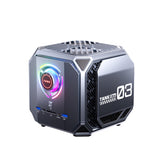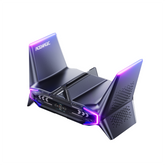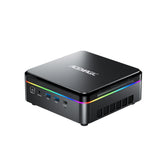Thunderbolt vs. USB-C: What’s the Difference?

Many laptops, monitors, and smartphones today come with compact reversible ports that look the same from the outside. Yet not all of them function the same way. The confusion between USB-C and Thunderbolt is common because both use the same oval-shaped connector. However, their capabilities differ significantly in terms of speed, display support, and professional use cases. Understanding the differences helps users avoid buying the wrong cable, docking station, or device, and ensures compatibility when planning upgrades.
Before comparing performance and use cases, it is important to define each technology. USB-C and Thunderbolt often overlap in design, but they represent different standards.
What is USB-C?
USB-C refers to the physical connector type introduced in 2014 as part of the USB 3.1 standard. It has replaced older USB-A and Micro-USB connectors in most modern devices. USB-C supports multiple protocols, including USB 2.0, USB 3.2, and USB4. Depending on the implementation, a USB-C port can handle:
- Data transfer rates from 480 Mbps (USB 2.0) to 20 Gbps (USB 3.2 Gen 2x2)
- Power delivery up to 100W using USB Power Delivery (USB-PD)
- Video output for up to 4K resolution on many laptops and tablets
Its popularity comes from being universal across smartphones, laptops, chargers, and accessories.
What is Thunderbolt?
Thunderbolt is a high-speed hardware interface originally developed by Intel in collaboration with Apple in 2011. Unlike USB-C, it is not just a connector but a full protocol that combines PCI Express (PCIe) and DisplayPort signals into a single cable. The latest version, Thunderbolt 4, supports:
- 40 Gbps data transfer rate
- Dual 4K or a single 8K monitor output
- Power delivery up to 100W
- Daisy-chaining of up to six devices
Because of these features, Thunderbolt is popular among creative professionals, gamers, and users with advanced docking setups.
Why People Confuse USB-C and Thunderbolt
The main reason for confusion is that both standards use the same USB-C connector shape. A Thunderbolt 3 or 4 port looks identical to a regular USB-C port. The difference lies in performance and compatibility. To distinguish them:
- Thunderbolt ports are usually marked with a lightning symbol
- USB-C ports may have the letters “SS” (SuperSpeed) or a charging symbol
Key takeaway: USB-C defines the connector, while Thunderbolt defines a protocol that operates through this connector.
Key Differences Between Thunderbolt and USB-C
Although both standards use the same connector, their technical specifications vary. The following sections break down the most important distinctions.
Speed and Bandwidth
Thunderbolt consistently outperforms standard USB-C in terms of speed.
USB-C 3.2 vs Thunderbolt 3/4 Transfer Rates
- USB-C 3.2 Gen 2x2: Up to 20 Gbps
- Thunderbolt 3 and 4: Up to 40 Gbps
This means Thunderbolt can move large video files, 3D assets, or game libraries in half the time compared to USB-C.
Impact of practical applications
In professional video editing, transferring a 100 GB 4K project takes:
- About 8 minutes over USB-C 3.2 Gen 2x2
- About 4 minutes over Thunderbolt 3/4
For everyday tasks such as moving photos or documents, both standards feel fast enough, but the gap matters for high-volume workflows.
Charging and Power Delivery
Both USB-C and Thunderbolt rely on the USB Power Delivery (USB-PD) standard.
- USB-C: Supports up to 100W charging on most laptops and 30–65W on smartphones and tablets.
- Thunderbolt: Uses the same USB-PD framework, typically capped at 100W for laptops.
Key difference: Thunderbolt does not provide higher charging wattage than USB-C. Instead, its strength lies in combining charging with high-speed data and display output in a single cable.
Display and External Monitor Support
USB-C
- Many USB-C ports support DisplayPort Alternate Mode, enabling one external monitor.
- Capabilities vary by device, with most limited to 4K at 60Hz.
Thunderbolt
- Thunderbolt 3 and 4 support dual 4K displays at 60Hz or a single 8K monitor at 60Hz.
- Also supports external GPU (eGPU) setups for gaming or rendering.
This makes Thunderbolt essential for advanced multi-monitor configurations.
Compatibility and Backward Support
- A Thunderbolt port accepts standard USB-C devices, including chargers, flash drives, and hubs.
- A USB-C port cannot use Thunderbolt devices that require PCIe speeds, such as eGPUs.
- Thunderbolt 4 is fully backward compatible with Thunderbolt 3.
This one-way compatibility is a major source of user confusion.
Cost and Availability
Thunderbolt components are more expensive due to stricter certification.
- USB-C cable (certified, 2 m): $10–$20
- Thunderbolt 4 cable (2 m): $30–$50
- USB-C hubs: Widely available at low cost
- Thunderbolt docks: Often $200–$350 due to added GPU, display, and PCIe support
Comparison Table: USB-C vs Thunderbolt
| Feature | USB-C (3.2 / USB4) | Thunderbolt 3/4 |
|---|---|---|
| Max Speed | 10–20 Gbps | 40 Gbps |
| Charging Power | Up to 100W (USB-PD) | Up to 100W (USB-PD) |
| Display Support | Typically 1 × 4K at 60Hz | 2 × 4K or 1 × 8K at 60Hz |
| Compatibility | Works with USB-C devices only | Works with USB-C and Thunderbolt |
| Cost of Accessories | Lower (common cables, hubs) | Higher (certified cables, docks) |
Thunderbolt vs. USB-C for Different Use Cases
Choosing between USB-C and Thunderbolt depends on how the device will be used. Each group of users has different requirements for speed, charging, and display support.
Everyday Users
For charging phones, syncing photos, or connecting a laptop to a projector, standard USB-C works well. Most users who browse the web, stream video, or do office work will not notice a performance gap. USB-C cables are also more affordable and easier to find.
Creative Professionals
Video editors, 3D designers, and photographers often deal with massive files and external storage devices. Thunderbolt’s 40 Gbps bandwidth allows faster project transfers and supports daisy-chaining multiple drives and monitors. This reduces wait times and improves editing workflows.
Gamers
Gamers benefit from Thunderbolt in specific setups. External GPUs (eGPUs) require Thunderbolt’s PCIe connection, which USB-C cannot provide. Thunderbolt also supports higher-resolution multi-monitor gaming environments. For casual gaming on laptops or single-display setups, USB-C is sufficient.
Business and Productivity
Professionals using docking stations, dual-monitor setups, and frequent data backups see clear value in Thunderbolt. It allows a single cable to connect a laptop to displays, storage, and power. However, for general office tasks, a USB-C hub provides enough connectivity at lower cost.
Use Case Comparison Table
| User Group | Recommended Standard | Key Reasons |
|---|---|---|
| Everyday Users | USB-C | Affordable, supports charging and basic data |
| Creative Pros | Thunderbolt | 40 Gbps speed, multi-monitor, external drives |
| Gamers | Thunderbolt | External GPUs, high-resolution multi-displays |
| Business/Office | Thunderbolt (optional) | Docking, fast backups, dual monitors |
How to Identify Thunderbolt vs. USB-C Ports and Cables
Because both technologies share the same connector shape, users often struggle to tell them apart. Fortunately, manufacturers include visual markers and certification logos to make identification easier.
Port Labeling
- USB-C port: Usually labeled with a plain USB trident logo (⚡ not included). Some may also include “SS” for SuperSpeed or a battery icon to indicate charging.
- Thunderbolt port: Always marked with a lightning bolt symbol. On laptops, this symbol appears next to the port.
Cable Markings and Certification
Cables are another source of confusion.
- USB-C cables: Certified ones may include “USB” with a speed rating such as “10” or “20” to indicate 10 Gbps or 20 Gbps capability.
- Thunderbolt cables: Certified Thunderbolt 3 and 4 cables feature a lightning bolt icon with a number (3 or 4) printed near the connector.
Buying uncertified cables can limit performance, even if the connectors look correct. For example, a low-cost USB-C cable may only support 480 Mbps despite having the same shape as a 20 Gbps version.
Testing Performance with Tools
If labeling is unclear, speed tests verify.
- Data transfer test: Moving a large file (e.g., 10 GB) between storage drives reveals if the connection runs at 10, 20, or 40 Gbps.
- System tools: On Windows, Device Manager lists connected controllers as “USB” or “Thunderbolt.” On macOS, System Information shows Thunderbolt devices separately.

Buying Guide – Choosing the Right Cable or Device
When selecting a cable or port standard, the choice depends on the type of tasks, devices in use, and budget. The following points help users make practical decisions.
When a Standard USB-C Cable is Enough
- Charging smartphones, tablets, and ultrabooks that use USB-PD
- Transferring documents, photos, and music files
- Connecting one external monitor at 4K resolution
- Using affordable hubs for USB drives, keyboards, and mice
For these everyday tasks, a certified USB-C cable provides full functionality without additional cost.
When to Invest in Thunderbolt Cables and Devices
- Editing large video projects requires 40 Gbps transfer speeds
- Running dual 4K monitors or one 8K monitor
- Using an external GPU for gaming or 3D rendering
- Creating a workstation setup with daisy-chained drives, docks, and displays
In these cases, Thunderbolt offers both performance and convenience by combining data, power, and display into one connection.
Avoiding Common Mistakes
- Buying uncertified cables: May lead to limited speed or unsafe charging. Always check for certification logos.
- Assuming all USB-C ports are equal: Some laptops advertise USB-C but only support USB 2.0 speeds.
- Mixing versions: Thunderbolt 4 cables support Thunderbolt 3 and USB-C, but not every USB-C cable supports Thunderbolt.
Quick Checklist
- ✅ Check the port icon: lightning bolt (Thunderbolt) vs USB logo (USB-C)
- ✅ Match cable certification with device requirements
- ✅ Confirm monitor resolution and refresh rate support
- ✅ Consider future upgrades (multi-monitor, external GPU) before buying
Conclusion
USB-C and Thunderbolt may look identical, but their roles in modern computing are distinct. USB-C is a universal connector type that supports multiple versions of the USB standard, offering affordable charging and data transfer for most users. Thunderbolt, developed by Intel, builds on the USB-C connector to deliver higher bandwidth, professional-grade display support, and advanced capabilities such as external GPUs and daisy-chaining.
The key distinction is simple: USB-C defines the connector, Thunderbolt defines the protocol. For everyday charging, syncing, and single-monitor setups, standard USB-C is sufficient. For professionals handling large files, gamers with external GPU setups, or anyone requiring dual 4K or 8K displays, Thunderbolt provides the performance advantage.
Understanding these differences prevents wasted spending on unnecessary hardware and helps users match the right cable or device to their needs.
FAQ
What is faster: Thunderbolt or USB-C?
Thunderbolt 3 and 4 support up to 40 Gbps, which is double the maximum of 20 Gbps on USB-C 3.2 Gen 2x2. For large file transfers and professional workloads, Thunderbolt is noticeably faster.
Can I use a USB-C device in a Thunderbolt port?
Yes. A Thunderbolt port accepts USB-C devices, including chargers, flash drives, and hubs. However, connecting a Thunderbolt device to a standard USB-C port will not provide Thunderbolt performance.
Is Thunderbolt the same as USB-C?
No. USB-C refers to the connector shape, while Thunderbolt refers to a protocol that uses this connector. Thunderbolt ports always use the USB-C connector, but not all USB-C ports support Thunderbolt.
Do I need Thunderbolt for charging?
Not necessarily. Both USB-C and Thunderbolt use the same USB Power Delivery standard and support up to 100W charging. Thunderbolt does not provide faster charging than USB-C.
What’s the difference between Thunderbolt 3 and Thunderbolt 4?
Both offer 40 Gbps bandwidth. Thunderbolt 4 improves the minimum requirements by guaranteeing support for two 4K monitors, PCIe at 32 Gbps, and mandatory USB4 compatibility. Thunderbolt 3 devices may vary in capabilities depending on manufacturer implementation.
Can USB-C support multiple monitors like Thunderbolt?
Some USB-C ports with DisplayPort Alternate Mode can handle a single 4K monitor, but most cannot match Thunderbolt’s ability to run dual 4K displays or one 8K monitor. Multi-monitor users benefit from Thunderbolt.
Which should I choose for gaming: USB-C or Thunderbolt?
For casual gaming on a laptop or single monitor, USB-C works fine. For advanced setups such as external GPUs (eGPUs) or high-resolution multi-monitor gaming, Thunderbolt is required because of its PCIe integration.







Leave a comment
Please note, comments need to be approved before they are published.